
The politics of Armenia take place in the framework of the parliamentary representative democratic republic of Armenia, whereby the president of Armenia is the head of state and the prime minister of Armenia the head of government, and of a multi-party system. Executive power is exercised by the president and the Government. Legislative power is vested in both the Government and Parliament.

The current Constitution of France was adopted on 4 October 1958. It is typically called the Constitution of the Fifth Republic(French: Constitution de la Ve République), and it replaced the Constitution of the Fourth Republic of 1946 with the exception of the preamble per a 1971 decision of the Constitutional Council. The current Constitution regards the separation of church and state, democracy, social welfare, and indivisibility as core principles of the French state.

The Constitution of the Czech Republic is the supreme law of the Czech Republic. The current constitution was adopted by the Czech National Council on 16 December 1992. It entered into force on 1 January 1993, replacing the 1960 Constitution of Czechoslovakia and the constitutional act No. 143/1968 Col., when Czechoslovakia gave way to the Slovak Republic and the Czech Republic in a peaceful dissolution.

The Constitution of the Republic of Lithuania defines the legal foundation for all laws passed in the Republic of Lithuania. The first constitution of the contemporary republic was enacted on 1 August 1922. The current constitution was adopted in a referendum on 25 October 1992.

The Italian Parliament is the national parliament of the Italian Republic. It is the representative body of Italian citizens and is the successor to the Parliament of the Kingdom of Sardinia (1848–1861), the Parliament of the Kingdom of Italy (1861–1943), the transitional National Council (1945–1946) and the Constituent Assembly (1946–1948). It is a bicameral legislature with 600 elected members and a small number of unelected members. The Italian Parliament is composed of the Chamber of Deputies, as well as the Senate of the Republic.
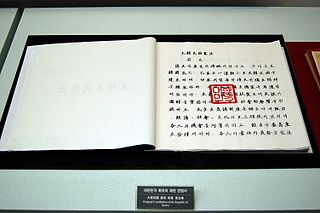
The Constitution of the Republic of Korea is the supreme law of South Korea. It was promulgated on July 17, 1948, and last revised on October 29, 1987.
Constitution of Estonia is the fundamental law of the Republic of Estonia and establishes the state order as that of a democratic republic where the supreme power is vested in its citizens. The first Constitution was adopted by the freely elected Estonian Constituent Assembly on 15 June 1920 and came into force on 21 December 1920. Heavily amended on 24 January 1934, following a referendum in 1933, it was in force until the second Constitution was enacted on 1 January 1938. It remained in force, de facto, until 16 June 1940, when the Soviet Union occupied Estonia and, de jure, until 28 June 1992, when the third and current Constitution of the Republic of Estonia was adopted by referendum.

The Constitution of Latvia is the fundamental law of the Republic of Latvia. Satversme is the oldest Eastern or Central European constitution still in force and the sixth oldest still-functioning republican basic law in the world. It was adopted, as it states itself in the text, by the people of Latvia, as represented in the Constitutional Assembly of Latvia, on 15 February 1922 and came into force on 7 November 1922. It was heavily influenced by Germany's Weimar Constitution and the Swiss Federal Constitution. The constitution establishes the main bodies of government ; it consists of 116 articles arranged in eight chapters.
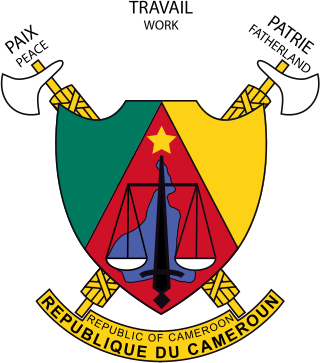
The Constitution of Cameroon is the supreme law of the Republic of Cameroon. Adopted in 1972, it is Cameroon's third constitution. The document consists of a preamble and 13 Parts, each divided into Articles. The Constitution outlines the rights guaranteed to Cameroonian citizens, the symbols and official institutions of the country, the structure and functions of government, the procedure by which the Constitution may be amended, and the process by which the provisions of the Constitution are to be implemented.

The current Constitution of Mongolia was adopted on 13 January 1992, put into force on 12 February, with amendments made in 1999, 2000 and 2019. The constitution established a representative democracy in Mongolia, enshrining core functions of the government, including the separation of powers and election cycle, and guaranteeing human rights including freedom of religion, travel, expression, private property. The document was written after the Mongolian Revolution of 1990, effectively dissolving the Mongolian People's Republic.
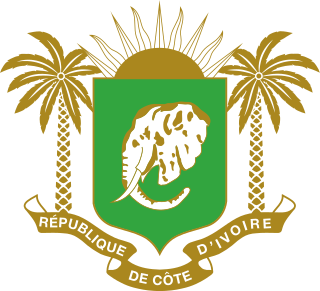
The Constitution of Ivory Coast was approved by referendum on October 30, 2016, and officially adopted on November 8, 2016.

The Constitution of Turkey, formally known as the Constitution of the Republic of Türkiye, also known as the Constitution of 1982, is Turkey's fundamental law. It establishes the organization of the government, and sets out the principles and rules of the state's conduct along with its responsibilities in regards to its citizens. The constitution also establishes the rights and responsibilities of the latter while setting the guidelines for the delegation and exercise that sovereignty belongs entirely and without doubt to the people.

The politics of France take place with the framework of a semi-presidential system determined by the French Constitution of the French Fifth Republic. The nation declares itself to be an "indivisible, secular, democratic, and social Republic". The constitution provides for a separation of powers and proclaims France's "attachment to the Rights of Man and the principles of National Sovereignty as defined by the Declaration of 1789".

The Provisional Constitution of the Federal Republic of Somalia is the supreme law of Somalia. It provides the legal foundation for the existence of the Federal Republic and source of legal authority. It sets out the rights and duties of its citizens, and defines the structure of government. The Provisional Constitution was adopted on August 1, 2012 by a National Constitutional Assembly in Mogadishu, Banaadir.

The Constitutional Court of Armenia is the highest legal body for constitutional review in Armenia. It is responsible for supervising the constitutionality of laws and other legislative instruments. The law of the constitutional court is defined in the Armenian constitution and by statute. The court, established in 1995, is located in Yerevan.
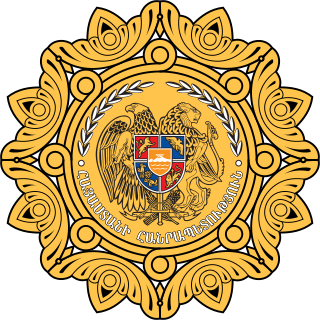
The president of Armenia is the head of state and the guarantor of independence and territorial integrity of Armenia elected to a single seven-year term by the National Assembly of Armenia. Under Armenia's parliamentary system, the president is simply a figurehead and holds ceremonial duties, with most of the political power vested in the parliament and prime minister.
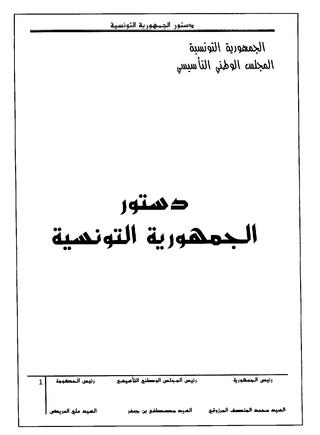
The Tunisian Constitution of 2014 was adopted on 26 January 2014 by the Constituent Assembly elected on 23 October 2011 in the wake of Tunisia's Jasmine Revolution that overthrew President Zine El Abidine Ben Ali. It was passed on 10 February 2014, replacing the constitutional law of 16 December 2011 that temporarily formed the basis of government after the suspension of the Constitution of 1959.

A constitutional referendum was held in Armenia on 6 December 2015. Its amendments to the constitution put the country on a course from having a semi-presidential system to being a parliamentary republic, with the changes beginning to take place during the 2017–18 electoral cycle. The referendum passed with 66.2% of voters supporting it. Voter turnout was 50.8%, passing the 33% threshold to validate the results.
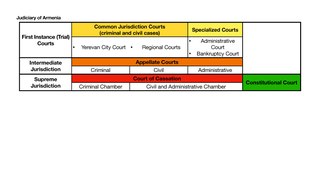
The Judiciary of Armenia interprets and applies the laws of Armenia. Under the doctrine of the separation of powers, judiciary exercises judicial power separately from the legislative power of Parliament and executive power of the Prime Minister. Per the Constitution, it is defined with a hierarchical structure regulated by the Supreme Judicial Council of Armenia. On the other hand, the Ministry of Justice of Armenia is a government agency which possesses executive authority and executes policies of the Government of Armenia in sectors that are closely associated with laws and regulations.

The 1973 Constitution of the Syrian Arab Republic was adopted on 13 March 1973 and was in use until 27 February 2012. It describes Syria's character to be Arab, democratic, socialist and republican. Further, in line with pan-Arab ideology, it positions the country as a region of the wider Arab world and its people as an integral part of the Arab nation. The constitution entrenched the power of the Arab Socialist Ba'ath Party, and its 8th Article described the party as "the leading party in the society and the state", effectively ruling Syria as a one-party socialist state under emergency laws.



















